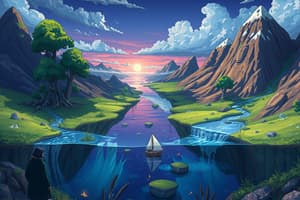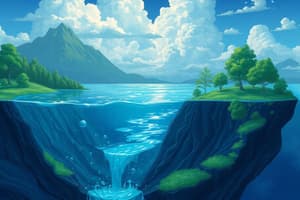Podcast
Questions and Answers
Which of the following best describes how solar energy influences the water cycle?
Which of the following best describes how solar energy influences the water cycle?
- It increases the rate of surface runoff by heating the ground.
- It directly causes precipitation by ionizing water molecules in the atmosphere.
- It causes condensation by supercooling water vapor in the upper atmosphere.
- It drives evaporation and sublimation, which move water into the atmosphere. (correct)
Why is evapotranspiration important in the water cycle?
Why is evapotranspiration important in the water cycle?
- It reduces surface runoff, preventing erosion.
- It returns water to the atmosphere from both plant transpiration and surface evaporation. (correct)
- It increases the amount of groundwater recharge.
- It directly contributes to the formation of subsurface water flow.
In which of the following scenarios would surface runoff be most likely to occur?
In which of the following scenarios would surface runoff be most likely to occur?
- After a light rain in a heavily forested area.
- After a heavy rainfall on already saturated soil. (correct)
- During a period of drought with very dry soil.
- In an area with sandy soil and low vegetation density.
How does vegetation affect the flow of water in terrestrial environments?
How does vegetation affect the flow of water in terrestrial environments?
Which of the following statements best describes the relationship between groundwater and the water cycle?
Which of the following statements best describes the relationship between groundwater and the water cycle?
How would deforestation in a watershed likely affect the water cycle in that area?
How would deforestation in a watershed likely affect the water cycle in that area?
What percentage of Earth's water is both freshwater and easily accessible?
What percentage of Earth's water is both freshwater and easily accessible?
Which of the following processes involves water changing directly from a solid to a gas?
Which of the following processes involves water changing directly from a solid to a gas?
Which of the following is the most significant contributor to the increase in atmospheric carbon dioxide since the Industrial Revolution?
Which of the following is the most significant contributor to the increase in atmospheric carbon dioxide since the Industrial Revolution?
How does groundwater contribute to the replenishment of surface water bodies like streams and lakes?
How does groundwater contribute to the replenishment of surface water bodies like streams and lakes?
What is a primary distinction between the two interconnected subcycles of the carbon cycle?
What is a primary distinction between the two interconnected subcycles of the carbon cycle?
Which of the following best describes the role of aquifers in the water cycle and human water usage?
Which of the following best describes the role of aquifers in the water cycle and human water usage?
How do minerals such as phosphorus and sulfur primarily cycle from land to water environments?
How do minerals such as phosphorus and sulfur primarily cycle from land to water environments?
How is carbon fundamentally important to living organisms?
How is carbon fundamentally important to living organisms?
Select the option that demonstrates the process of precipitated water that infiltrates the soil:
Select the option that demonstrates the process of precipitated water that infiltrates the soil:
What is the role of fossil fuels in the context of the carbon cycle?
What is the role of fossil fuels in the context of the carbon cycle?
Which of the following statements accurately describes the flow of matter and energy in ecosystems?
Which of the following statements accurately describes the flow of matter and energy in ecosystems?
Which element is a key component of nucleic acids and phospholipids?
Which element is a key component of nucleic acids and phospholipids?
Which of the following geological processes does NOT significantly contribute to the cycling of elements on Earth?
Which of the following geological processes does NOT significantly contribute to the cycling of elements on Earth?
Why is the term 'biogeochemical cycles' used to describe the recycling of inorganic matter?
Why is the term 'biogeochemical cycles' used to describe the recycling of inorganic matter?
How are the cycles of different elements interconnected within an ecosystem?
How are the cycles of different elements interconnected within an ecosystem?
Most of the Earth's water is located in:
Most of the Earth's water is located in:
If the total amount of freshwater on Earth remains constant, but the amount of ice decreases, what is the MOST likely immediate consequence?
If the total amount of freshwater on Earth remains constant, but the amount of ice decreases, what is the MOST likely immediate consequence?
What percentage of freshwater on Earth is readily accessible in lakes and rivers?
What percentage of freshwater on Earth is readily accessible in lakes and rivers?
Which of the following best describes the role of autotrophs in the biological carbon cycle?
Which of the following best describes the role of autotrophs in the biological carbon cycle?
How does the process of respiration contribute to the carbon cycle?
How does the process of respiration contribute to the carbon cycle?
Which of the following is NOT considered a carbon reservoir?
Which of the following is NOT considered a carbon reservoir?
What is the primary way carbon is passed from producers to higher trophic levels?
What is the primary way carbon is passed from producers to higher trophic levels?
Which of the following processes returns stored carbon from fossil fuels back into the active carbon cycle?
Which of the following processes returns stored carbon from fossil fuels back into the active carbon cycle?
Which of the following statements accurately describes the connection between the biological and biogeochemical carbon cycles?
Which of the following statements accurately describes the connection between the biological and biogeochemical carbon cycles?
If deforestation increases, how would this affect the carbon cycle?
If deforestation increases, how would this affect the carbon cycle?
A scientist is studying a sealed ecosystem. They observe that the rate of photosynthesis is significantly higher than the rate of respiration. What long-term effect would this imbalance likely have on the ecosystem's atmospheric composition?
A scientist is studying a sealed ecosystem. They observe that the rate of photosynthesis is significantly higher than the rate of respiration. What long-term effect would this imbalance likely have on the ecosystem's atmospheric composition?
Which of the following best describes the role of nitrogen-fixing bacteria in the nitrogen cycle?
Which of the following best describes the role of nitrogen-fixing bacteria in the nitrogen cycle?
The process of denitrification, performed by bacteria, has which of the following effects on the nitrogen cycle?
The process of denitrification, performed by bacteria, has which of the following effects on the nitrogen cycle?
Why is organic nitrogen crucial for the study of ecosystem dynamics?
Why is organic nitrogen crucial for the study of ecosystem dynamics?
How does the combustion of fossil fuels impact the nitrogen cycle?
How does the combustion of fossil fuels impact the nitrogen cycle?
What is the primary effect of using artificial fertilizers containing nitrogen and phosphorus on the nitrogen cycle and aquatic ecosystems?
What is the primary effect of using artificial fertilizers containing nitrogen and phosphorus on the nitrogen cycle and aquatic ecosystems?
Which of the following is a consequence of increased nitrous oxide (N2O) levels in the atmosphere?
Which of the following is a consequence of increased nitrous oxide (N2O) levels in the atmosphere?
Nitrogen runoff from fertilizers primarily affects which part of the nitrogen cycle in aquatic ecosystems?
Nitrogen runoff from fertilizers primarily affects which part of the nitrogen cycle in aquatic ecosystems?
What is the role of ammonification in the nitrogen cycle?
What is the role of ammonification in the nitrogen cycle?
How do terrestrial ecosystems primarily obtain sulfates from weathered rocks?
How do terrestrial ecosystems primarily obtain sulfates from weathered rocks?
Which of the following processes contributes to the release of sulfur back into the atmosphere from terrestrial ecosystems?
Which of the following processes contributes to the release of sulfur back into the atmosphere from terrestrial ecosystems?
What is the primary mechanism by which sulfur enters the ocean from land?
What is the primary mechanism by which sulfur enters the ocean from land?
How does the burning of fossil fuels contribute to acid rain formation?
How does the burning of fossil fuels contribute to acid rain formation?
What is the impact of acid rain on aquatic ecosystems?
What is the impact of acid rain on aquatic ecosystems?
Which of the following is a direct consequence of acid rain on the man-made environment?
Which of the following is a direct consequence of acid rain on the man-made environment?
Which of the following natural processes does NOT introduce sulfur into the environment?
Which of the following natural processes does NOT introduce sulfur into the environment?
What role do chemoautotrophs play in marine ecosystems regarding the sulfur cycle?
What role do chemoautotrophs play in marine ecosystems regarding the sulfur cycle?
Flashcards
Biogeochemical Cycles
Biogeochemical Cycles
The recycling of inorganic matter between living organisms and their nonliving environment.
6 Common Elements
6 Common Elements
Carbon, nitrogen, hydrogen, oxygen, phosphorus, and sulfur.
Hydrosphere
Hydrosphere
The area of Earth where water movement and storage occurs (oceans, lakes, groundwater, ice, atmosphere).
Water's Role in Mineral Cycling
Water's Role in Mineral Cycling
Signup and view all the flashcards
Saltwater Percentage
Saltwater Percentage
Signup and view all the flashcards
Freshwater Storage
Freshwater Storage
Signup and view all the flashcards
Available Freshwater
Available Freshwater
Signup and view all the flashcards
Increasing Water Availability
Increasing Water Availability
Signup and view all the flashcards
Photosynthesis
Photosynthesis
Signup and view all the flashcards
Respiration
Respiration
Signup and view all the flashcards
Carbon Sequestration
Carbon Sequestration
Signup and view all the flashcards
Carbon Emission
Carbon Emission
Signup and view all the flashcards
Autotrophs
Autotrophs
Signup and view all the flashcards
Heterotrophs
Heterotrophs
Signup and view all the flashcards
Carbon Reservoirs
Carbon Reservoirs
Signup and view all the flashcards
Biological Carbon Cycle
Biological Carbon Cycle
Signup and view all the flashcards
Water Cycle
Water Cycle
Signup and view all the flashcards
Groundwater
Groundwater
Signup and view all the flashcards
Evaporation
Evaporation
Signup and view all the flashcards
Aquifers
Aquifers
Signup and view all the flashcards
Sublimation
Sublimation
Signup and view all the flashcards
Carbon Cycle
Carbon Cycle
Signup and view all the flashcards
Condensation and Precipitation
Condensation and Precipitation
Signup and view all the flashcards
Fossil Fuels
Fossil Fuels
Signup and view all the flashcards
Carbon
Carbon
Signup and view all the flashcards
Surface Runoff
Surface Runoff
Signup and view all the flashcards
Carbon Dioxide (CO2)
Carbon Dioxide (CO2)
Signup and view all the flashcards
Transpiration
Transpiration
Signup and view all the flashcards
Evapotranspiration
Evapotranspiration
Signup and view all the flashcards
Evaporation
Evaporation
Signup and view all the flashcards
Condensation
Condensation
Signup and view all the flashcards
Groundwater
Groundwater
Signup and view all the flashcards
Weathering (Sulfur)
Weathering (Sulfur)
Signup and view all the flashcards
Decomposition (Sulfur)
Decomposition (Sulfur)
Signup and view all the flashcards
Sulfur Deposits on Land
Sulfur Deposits on Land
Signup and view all the flashcards
Sulfur in Rain
Sulfur in Rain
Signup and view all the flashcards
Fallout (Sulfur)
Fallout (Sulfur)
Signup and view all the flashcards
Plant Uptake of Sulfates
Plant Uptake of Sulfates
Signup and view all the flashcards
Sulfur Sources in the Ocean
Sulfur Sources in the Ocean
Signup and view all the flashcards
Acid Rain
Acid Rain
Signup and view all the flashcards
Denitrification
Denitrification
Signup and view all the flashcards
Nitrogen Fixation
Nitrogen Fixation
Signup and view all the flashcards
Human Impact on Nitrogen cycle
Human Impact on Nitrogen cycle
Signup and view all the flashcards
Acid Rain and Nitrogen
Acid Rain and Nitrogen
Signup and view all the flashcards
Nitrous Oxide (N2O)
Nitrous Oxide (N2O)
Signup and view all the flashcards
Nitrogen and Food Webs
Nitrogen and Food Webs
Signup and view all the flashcards
Nitric Acid
Nitric Acid
Signup and view all the flashcards
Nitrogen Gas Conversion
Nitrogen Gas Conversion
Signup and view all the flashcards
Study Notes
- Matter is conserved and recycled in ecosystems, unlike energy, which flows directionally.
- Key elements like carbon, nitrogen, hydrogen, oxygen, phosphorus, and sulfur cycle through the environment and organisms.
- Cycling is influenced by geological processes like weathering and subduction, as well as chemistry, forming what are known as biogeochemical cycles.
The Water Cycle
- The hydrosphere encompasses all water on Earth, including surface water, groundwater, ice, and atmospheric water vapor.
- Most Earth's water is saltwater (97.5%), with the remaining being mostly groundwater or ice.
- Less than 1% of the total water on Earth is accessible freshwater in lakes and rivers.
- The water cycle is driven by solar energy, involving evaporation (liquid to vapor) and sublimation (ice to vapor).
- Water vapor condenses into clouds, leading to precipitation (rain, snow, hail) that returns water to Earth.
- Surface runoff is the flow of freshwater over land, contributing to streams and lakes.
- Transpiration is when water evaporates from plants
- Evapotranspiration is the combined process of transpiration and evaporation.
- Groundwater is a significant source of fresh water, found in soil pores and rock fissures.
- Aquifers are groundwater reservoirs that serve as sources for drinking and irrigation water.
- Rain and runoff cycle minerals like phosphorus and sulfur from land to water
The Carbon Cycle
- Carbon is the second most abundant element in organisms and the foundation of organic molecules.
- Carbon compounds store energy, with fossil fuels representing carbon from ancient organisms.
- Increased use of fossil fuels since the Industrial Revolution has caused a drastic increase in carbon dioxide in the atmosphere, contributing to climate change.
- The carbon cycle is divided into rapid carbon exchange among living organisms and long-term cycling through geological processes.
- Carbon dioxide (CO2) is used by autotrophs via photosynthesis to create high-energy compounds such as glucose.
- Energy from the covalent bonds is stored, linking carbon atoms together, which is then used for respiration.
- Carbon passes from producers to higher trophic levels through consumption.
- Respiration breaks down organic molecules, releasing carbon as CO2 back into the atmosphere.
- Carbon reservoirs are regions where carbon is stored for extended periods: atmosphere, liquid water, ocean sediment, soil, rocks, the Earth’s interior
- Calcium carbonate from marine organism shells forms limestone, the largest carbon reservoir on Earth.
- Carbon is also stored in soil as organic carbon from decomposition and weathering.
- Subduction moves ocean floor carbon sediments deep within Earth, later released as CO2 through volcanic activity or hydrothermal vents.
The Nitrogen Cycle
- Plants and phytoplankton cannot directly use atmospheric nitrogen (N2).
- Nitrogen enters the biological world via nitrogen fixation by free-living and symbiotic bacteria. The bacteria convert nitrogen to ammonia (NH3), which becomes ammonium (NH4+).
- Bacteria convert ammonium into nitrites (NO2-) and then nitrates (NO3-), which producers use to make organic molecules.
- Denitrification converts nitrates back into nitrogen gas, returning it to the atmosphere.
- Human activities, such as the combustion of fossil fuels and fertilizer use, alter the nitrogen cycle.
- Nitrogen can become nitric acid HNO3, which contributes to acid rain.
- Nitrogen can become nitrous oxide N2O, which casuses greenhouse gas effects.
- Eutrophication occurs when fertilizer runoff leads to overgrowth of algae, oxygen depletion, and death of aquatic life.
The Phosphorus Cycle
- Phosphorus is essential for nucleic acids, phospholipids, and bone components.
- It is often a limiting nutrient in aquatic ecosystems.
- Phosphorus occurs as phosphate ion (PO43-).
- Phosphate is released into the environment through weathering of rocks.
- Phosphorus also occurs due to human activity by being released due to runoff.
- Ocean sediments containing phosphate are moved to land through geological uplifting.
- Excessive phosphorus and nitrogen cause algal overgrowth, leading to oxygen depletion and dead zones in aquatic ecosystems.
- Dead zones are areas depleted of normal flora and fauna due to factors like eutrophication, oil spills and toxic chemicals.
The Sulfur Cycle
- Sulfur is essential for amino acids and protein formation.
- Sulfur cycles between oceans, land, and the atmosphere.
- Atmospheric sulfur exists as sulfur dioxide (SO2).
- Sulfur dioxide enters the atmosphere through decomposition, volcanic activity, geothermal vents, and burning fossil fuels.
- Sulfur returns to land by precipitation (as weak sulfuric acid) or direct fallout.
- Rocks release sulfur through weathering, and terrestrial ecosystems take up sulfates (SO4) through plant roots.
- Human activities like burning fossil fuels release hydrogen sulfide gas into the atmosphere.
- Acid rain is created when sulfur compounds mix with rainwater, causing damage to ecosystems and human-made structures.
Studying That Suits You
Use AI to generate personalized quizzes and flashcards to suit your learning preferences.




